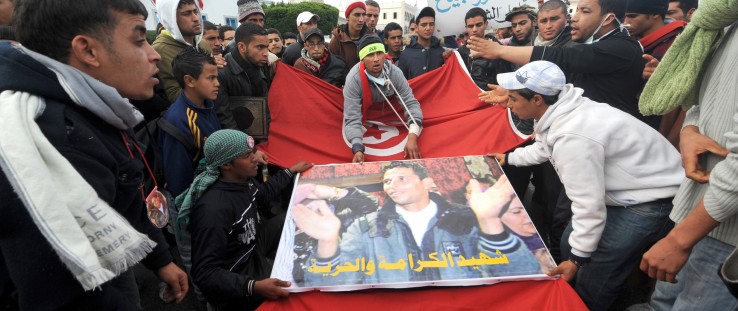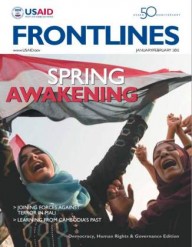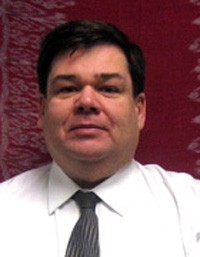 Tunisians from the Kasserine region walk with a Mohammed Bouazizi poster and the national flag in front of the government palace in Tunis, Jan. 28, 2011.
Fethi Belaid, AFP
Tunisians from the Kasserine region walk with a Mohammed Bouazizi poster and the national flag in front of the government palace in Tunis, Jan. 28, 2011.
Fethi Belaid, AFP
 Tunisians from the Kasserine region walk with a Mohammed Bouazizi poster and the national flag in front of the government palace in Tunis, Jan. 28, 2011.
Fethi Belaid, AFP
Tunisians from the Kasserine region walk with a Mohammed Bouazizi poster and the national flag in front of the government palace in Tunis, Jan. 28, 2011.
Fethi Belaid, AFP
QUESTION: Why were these elections important?
JOSEPH TAGGART: In January, Tunisians’ frustration with autocratic rule, the lack of economic opportunity, and having no voice in how their country was governed boiled over into massive citizen-led street protests that sparked what would be dubbed the “Arab Spring.” Citizens in neighboring countries were inspired by what transpired in Tunisia and felt empowered to shake off decades of autocratic rule in their own countries.
The Constituent Assembly election marked the first election since the start of the Arab Spring, and was the first test for Tunisia and the region. It marked a turning point in demonstrating whether citizens who marched in the streets were also willing to peacefully cast ballots in significant numbers.
On Oct. 23, Tunisians turned out in record numbers, peacefully standing in line for hours to participate in elections that were determined to be free, representative, and transparent. The elections marked the first truly democratic elections in Tunisia and have set a course for a representative body of the people to begin drafting a new constitution which will lay the governing political and economic framework for Tunisia.
Q: What kinds of influence will first-time politicians, particularly women and other underrepresented groups, have in remaking their society when they join with other lawmakers to begin work on a new constitution?
TAGGART: Tunisia’s elections were an important political victory for the country’s women. Roughly one quarter of the seats in the 218-member assembly are now held by women, which is the largest percentage of women in any assembly in the region. The Constituent Assembly has a diverse make-up, including citizen activists, members of the former opposition, and those new to the political realm. Consequently, Tunisia’s constitution will be written by a broad spectrum of Tunisia’s society—a marked departure from its past, where only a handful of ruling elite were allowed to influence Tunisian laws and governing system.
Q: What did USAID do to assist the Tunisians as they conducted their first democratic elections?
TAGGART: I want to note that, from day one, the process in Tunisia has been led and managed by the Tunisians. After the events in January, Tunisians were very clear that they would lead the transition, that they have a vision, and that they would manage this process based on priorities expressed by Tunisian citizens. USAID contributed to this process by supporting peer-to-peer networking opportunities between Tunisian democratic reformers and those from other parts of the world, based on Tunisian requests. Through those peer-to peer-consultations, democratic reformers shared best practices regarding transparent election processes, systems, and grass roots political campaigning. USAID also supported Tunisian-led and designed citizen- and voter-education efforts and training for first-time and women candidates.
Q: What were your impressions regarding Tunisian efforts in administering these elections?
TAGGART: The extraordinary turnout of voters across Tunisia reflected Tunisians’ determination to see through the process that they had initiated, as well as their confidence in the Independent Election Commission of Tunisia (ISIE). The Tunisians had only a few months to prepare for an election on which, in many ways, the momentum of the Arab Spring hinged. They succeeded in carrying out a process that was declared inclusive, transparent, and credible—an extraordinary and historic achievement in such a short amount of time. The voting took place in a positive, festive, and very patriotic atmosphere.
In spite of waiting periods of several hours in many places, the mood of the voters and poll workers was summed up by one 50-year-old gentleman who had waited over 4½ hours to cast his vote: “I have waited my entire life for this day….I can wait a few hours more!”
I count myself very fortunate to have witnessed history in the making. I have worked with USAID democracy, human rights, and governance programs for over 15 years, and observed dozens of elections, but nothing compares to what I witnessed in Tunisia in October. The Tunisians’ spirit and pride inspired me and reminded me once again what a truly wonderful opportunity it is to work for USAID.
Q: In what way is Tunisia a model for other countries in the Middle East? And in what ways is it not?
TAGGART: Tunisia’s Oct. 23 elections were the first competitive elections in the Arab world since the region’s uprisings began. With this election, Tunisians sent a resounding signal that a peaceful and democratic transition is truly underway in the Middle East. While the Tunisian uprising in January served as an inspiration for the Arab Spring, each of the uprisings that followed in the region have taken on their own unique character and will follow different trajectories. It is the job of USAID to support these transitions—and the inspiring citizens who are leading the way—so that they meet the promise and expectations of citizens across the region.










Comment
Make a general inquiry or suggest an improvement.